React is a viral and one of the best front-end libraries as of today; this has become many developers primary library for creating front-end applications.
On the other hand, Typescript is a strict and statically typed programming language, making our JavaScript code more predictable. As developers, our goal is not just to create products but to create products where we can always predict their behavior; this is one of the main reasons Typescript was created.
Introduction
Using Typescript to build our React applications will make our react applications more predictable as we will be able to catch a lot of errors at runtime (during compilation).
In this article, I’ll explain the following while building a simple Todo Application:
- How to bootstrap a react typescript application.
- What are types and interfaces in Typescript and how to use them.
- How to declare types for states and props in functional components.
- Events and how to deal with event types in our react applications.
- How to declare types for states and props in class base components.
If you are interested in the code alone, you can check out this Github repo here.
This article isn’t a beginner guide to React or Typescript, but instead, it will guide us on integrating Typescript in React applications.
Setup a react typescript application
We use Create React App to set up our react application that way, we do not need to worry about all the webpack and babel stress.
As you might have guessed, to set up a react typescript application, we’d still use create-react-app just with some extra flags. In our terminal, we’d type the following to bootstrap our application.
npx create-react-app todo-app --template typescript
This command will create a react typescript application for us then we can set up the server as we will normally. Our app structure should look like this.
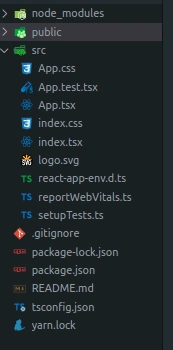
Let’s test that everything is working fine, we need to run the app by typing the following:
npm start #or yarn start
You can check out this link for more details about setting up a react typescript app with create-react-app
Types and interfaces
Before we start talking about our application, let’s talk about one of the essential features of Typescript, types, and interfaces.
These two things are very much alike, and we might not even be able to spot the differences, but there are some differences. Types and interfaces mainly tell us more about what an object or data is, its datatype, what it can contain, and all.
Let’s look at some examples:
let num: number = 4
const name: string = "John Doe"
The example above is pretty straightforward. In this case, we do not have to specify the type of the variables; Typescript is smart enough to determine the type.
type something = string
type IProps = {
disabled: false,
title: "Hello" | "Hi"
}
interface Props {
disabled: boolean,
title: string
}
const props_types: IProps = {
disabled: false,
title: "Hello"
}
const props_interface: Props = {
disabled: false,
title: "Hello"
}
const data: something = "Hey"
As we can see, we were able to define a type for more complex data, and we can use this idea to model much more complex data. From this example, we might be able to see a difference between type and interface.
More details about our application
In our App.tsx file, we need to delete everything inside the function and return a simple text.
import React 'react'
function App() {
return <h1>Hello World</h1>
}
export default App;
Now let’s think about the logic of the application. To make things simple, we’d have the code for the whole app inside this file.
We need two components to sit inside the App component, AddTodoComponent and TodosComponent. These two components will be responsible for creating a new todo and displaying the list of todos that have been created, respectively.
AddTodoComponent: This component contains a form with one input field. When the Add button is clicked, new todo data is added to the state, and then theTodosComponentis updated.TodosComponent: This component contains a list of all the create todos. We can toggle the completed field of todo and delete a todo.
How to declare types in react applications
Let’s create a type for our Todo object, inside the App.tsx file place this object after the import.
type ITodo = {
// Our todo should have the title and completed fields and the id field to
id: number;
title: string;
completed: boolean;
}
type ITodos = {
todos: ITodo[], // Our Todos is an array of Todo
}
How to declare state and props in a functional component
We’d see different ways to declare a type for props in a functional component, and we’d also see how to declare the type for state in a functional component.
To declare props for a functional component, we can either use normal type definition for functions, or we can pass the type as a generic type to the React.FC type.
Let’s see how we can demonstrate the initial by creating our AddTodoComponent. This component has its state, and it also accepts props with one field, addTodos, a function that takes in a string and returns nothing. It just updates the ITodos state.
To declare a type for a state in a functional component, all we need to do is pass that state’s type as a generic type to useState.
const AddTodoComponent = ({addTodos} : {addTodos: (text: string) => void}) => {
const [todo, setTodo] = React.useState<string>("");
const submit = (e: React.MouseEvent<HTMLButtonElement, MouseEvent>) => {
e.preventDefault();
if (!todo) {
alert("Please enter a todo");
} else {
addTodos(todo);
setTodo("");
}
};
return (
<div className="AddTodo">
<form>
<input
value={todo}
onChange={e => {setTodo(e.target.value)}} />
<button onClick={submit}>Add</button>
</form>
</div>
);
};
What goes in the component is pretty straightforward, but the submit function defined inside this component is worth talking about. This function takes in an event object and returns void.
Event types in react
Now the question how do we get to know the type that’s passed to the event?
Well, React has a lot of events, but we certainly can not know the type assigned to each of them, so what I normally do is to put the event object in the handler that it’s being used and hover on it, then copy the type.
<button onClick={e => {console.log(e) }}>Add</button>
(parameter) e: React.MouseEvent<HTMLButtonElement, MouseEvent>
Then we can pass the type to the function; that seems cool, right!
Declaring prop types using ‘React.FC’
Let’s create our TodosComponent below the root App component definition:
const TodosComponent: React.FC<{
todos: ITodos,
toggleTodos: (id: number) => void,
deleteTodos: (id: number) => void
}> = ({todos, toggleTodos, deleteTodos}) => {
const deleteTodo = (id: number) => {
if (window.confirm(`Are you sure you want to delete todo?`)) {
deleteTodos(id);
}
}
return (
<div className="section__todos">
<h2>Todos</h2>
{todos.todos.length ? <ul className="todos">
{todos.todos.map(todo => (
<li key={todo.id}>
<span style={{textDecoration: todo.completed? 'line-through': 'none'}}>{todo.title}</span>
<input
type="checkbox"
checked={todo.completed}
onChange={() => toggleTodos(todo.id)} />
<button onClick={() => {deleteTodo(todo.id)}}>X</button>
</li>
))}
</ul>: <div>No Todo has been created</div>}
</div>
);
};
React gives us access to some in-built types that we can use; one of them is the React.FC type which we use to tell Typescript that this function returns JSX and is a functional component.
React.FC is a general type which means it takes in another Type. This type indicates the kind of props this function is expecting. This makes sense as we’re ensuring that the component will be used correctly; otherwise, there will be a compilation error.
This component expects the following props:
todos: This is of the typeITodosthat was declared earlier. The todos array is the array of all todos.toggleTodos: This function takes in an integer (id) and returns nothing (void); all it does is change the completed field of the currentITodo.deleteTodos: This is similar totoggleTodosexcept for the fact that instead of toggling it, it removes it from the state(ITodosarray).
What is going on inside the function is pretty much straightforward.
So far, we’ve created the components that we need in our application, but our app is empty because we have not connected it to the root App component.
Let’s update our root App component to the following.
function App() {
const [todos, setTodos] = React.useState<ITodos>({todos: []});
const addTodos = (title: string) => {
setTodos({
todos: [
{title, completed: false, id: todos.todos.length+1},
...todos.todos
]
});
};
const deleteTodos = (id: number) => {
setTodos({
todos: todos.todos.filter(t => t.id !== id)
});
};
const toggleTodos = (id: number) => {
setTodos({
todos: todos.todos.map(todo => todo.id === id ? {...todo, completed: !todo.completed} : todo)
});
}
return (
<div className="App">
<AddTodoComponent addTodos={addTodos} />
<hr />
<TodosComponent
todos={todos}
toggleTodos={toggleTodos}
deleteTodos={deleteTodos} />
</div>
);
}
This component has a state ITodos and three functions, which are passed down as props to the children component; there isn’t anything special in the element.
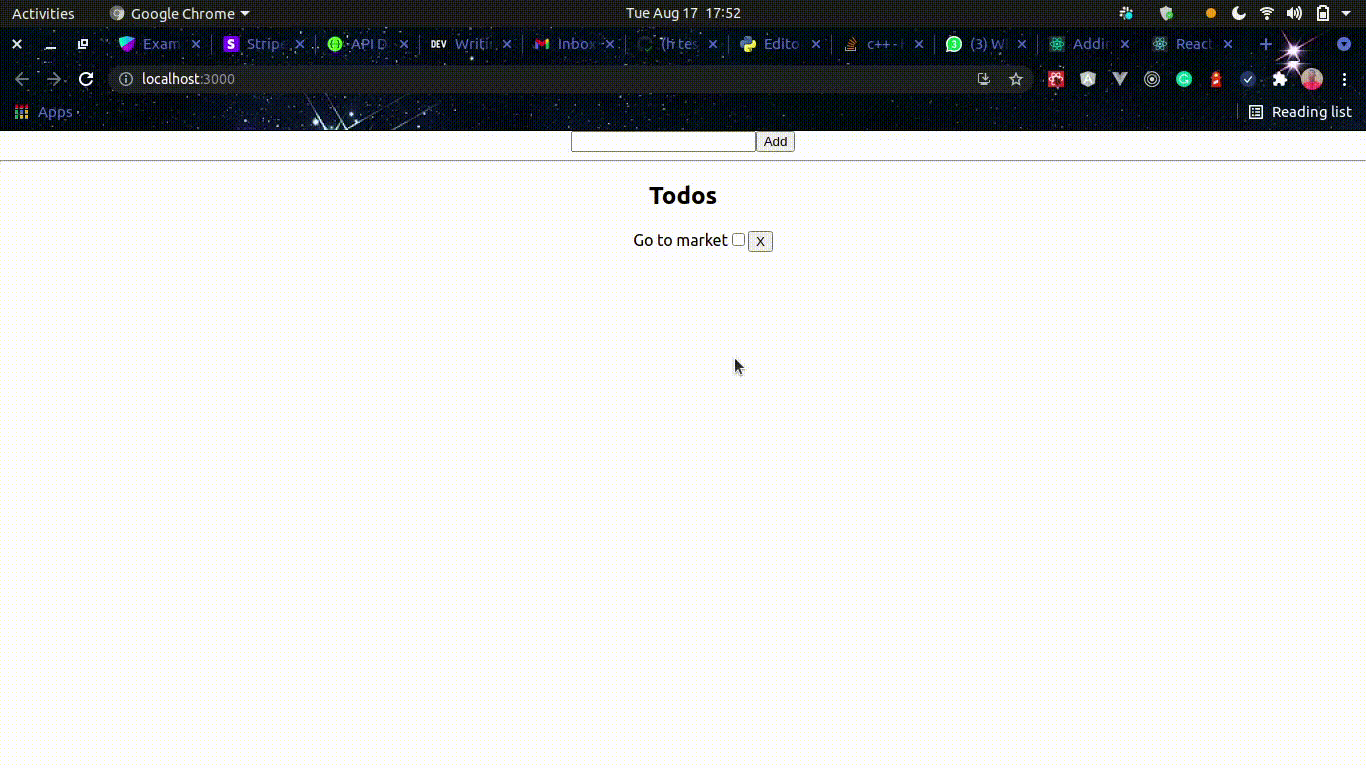
How to declare types for state and props in a dlass-based component
So far, we’ve been talking about functional components, but what if the codebase you’re working with is a class-based component Then we need to figure out a way to connect our app with it.
Everything remains the same except for how we create state and props, and that’s because they are created differently. We need to pass the prop type and state type as a generic type to React.Component.
class App extends React.Component<IProps, Istate> {
constructor(props: IProps) {
super(props)
this.state = {
// your state should be in here
}
}
// Your helper functions and component life cycle
render () {
// return your JSX here
}
}
Conclusion
This article has explained how to integrate Typescript in your React applications by building a Simple Todo App. You can contact me on Twitter if you have any questions. You can also check the full code on Github.
Futher Reading
You can check out the following resources for a deeper guide on React and Typescript.
Happy coding!





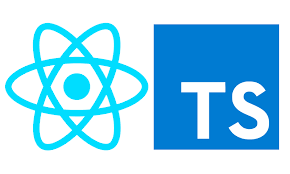

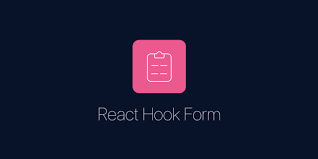
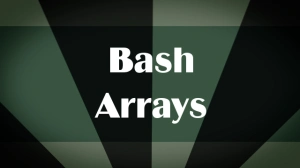

Comments: